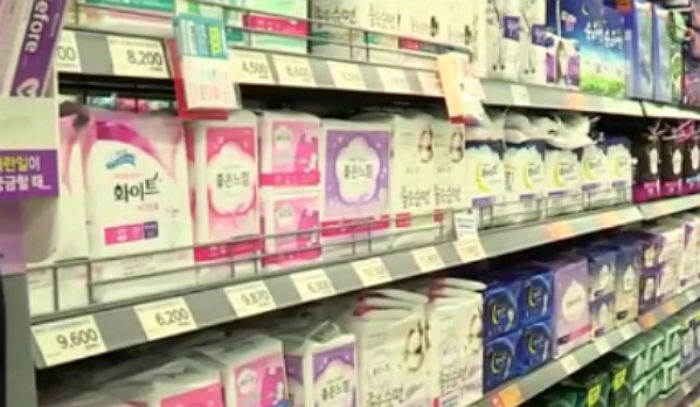hankyoreh
Links to other country sites 다른 나라 사이트 링크
Another price hike will mean more women without feminine hygiene products

Yuhan-Kimberly, South Korea’s biggest seller of tampons and sanitary pads, announced on May 23 that prices for the products will go up in June. The news prompted many low-income women to share hair-raising experiences with high feminine hygiene product costs on Twitter and other social networking services.
“The teacher at our school went to visit a student who had been out sick for a week, and found her lying on top of a towel because she didn’t have the money to buy tampons,” recalled one Twitter user. “Both of them were weeping over it.”
The towel story led to an outpouring of similar accounts on social media.
“A friend of mine whose parents were struggling used a shoe insert as a sanitary pad,” wrote another Twitter user.
“It’s more common than people think,” wrote a third. “There was a time when our family couldn’t afford to buy replacement pads, and I would get them from the health center every day, saying I’d left them at home.”
Kim Jin-suk, a member of the guidance committee for the Korean Confederation of Trade Unions, tweeted on May 27 that pads and tampons were the “number one most stolen item from lockers in my old factory dormitory.”
“I had thought all those stories about fifteen- and sixteen-year-old girls without the money to buy tampons were just a legend,” she wrote.
In 2004, feminine hygiene products were exempted from value-added taxes. But repeated company hikes in the cost every two to three years have resulted in a silent burden for many young women from low-income families. A medium-sized pack containing 36 pads sells for an average of 6,000 won to 9,000 won (US$6-7.50) today.
In cases where families are struggling financially or have no other female members, young women often find it difficult to discuss the sensitive topic with others. Women’s groups estimate that as many as 60,000 low-income young women aged 15 to 19 could be faced with difficulties accessing feminine hygiene products.
“The situation these days is one where girls raised by grandparents or single parents are using toilet paper from the school bathroom [instead of pads],” said lawmaker Kim Myung-yeon at the National Assembly Gender and Equality Committee meeting last July.
“We need to determine the annual demand and reflect that in the budget,” Kim said at the time.
But the remarks did not lead to any public debate on the issue.
“They‘ve been making policy proposals for support on hygiene products for young women in low-income, single-parent families for the last ten years, but it hasn’t happened yet,” said Hwang Eun-sook, chairperson of the group Single Parent.
Single Parent is currently raising funds through the social venture Ease and More to provide support for feminine hygiene products to 150 young women over a period of six months.
“We’ve had over 500 people donate in the past two to three days, but it’s not clear whether the donations will continue, so we‘re not really in a position to expand the program,” said Ease and More president Ahn Ji-hye.
By Park Su-ji, staff reporter
Please direct questions or comments to [english@hani.co.kr]

Editorial・opinion
![[Editorial] Does Yoon think the Korean public is wrong? [Editorial] Does Yoon think the Korean public is wrong?](https://flexible.img.hani.co.kr/flexible/normal/500/300/imgdb/original/2024/0417/8517133419684774.jpg) [Editorial] Does Yoon think the Korean public is wrong?
[Editorial] Does Yoon think the Korean public is wrong?![[Editorial] As it bolsters its alliance with US, Japan must be accountable for past [Editorial] As it bolsters its alliance with US, Japan must be accountable for past](https://flexible.img.hani.co.kr/flexible/normal/500/300/imgdb/original/2024/0417/6817133413968321.jpg) [Editorial] As it bolsters its alliance with US, Japan must be accountable for past
[Editorial] As it bolsters its alliance with US, Japan must be accountable for past- [Guest essay] Amending the Constitution is Yoon’s key to leaving office in public’s good graces
- [Editorial] 10 years on, lessons of Sewol tragedy must never be forgotten
- [Column] A death blow to Korea’s prosecutor politics
- [Correspondent’s column] The US and the end of Japanese pacifism
- [Guest essay] How Korea turned its trainee doctors into monsters
- [Guest essay] As someone who helped forge Seoul-Moscow ties, their status today troubles me
- [Editorial] Koreans sent a loud and clear message to Yoon
- [Column] In Korea’s midterm elections, it’s time for accountability
Most viewed articles
- 1‘Right direction’: After judgment day from voters, Yoon shrugs off calls for change
- 2[Editorial] Does Yoon think the Korean public is wrong?
- 3[Editorial] As it bolsters its alliance with US, Japan must be accountable for past
- 4Japan officially says compensation of Korean forced laborers isn’t its responsibility
- 5Strong dollar isn’t all that’s pushing won exchange rate into to 1,400 range
- 6[Guest essay] How Korea turned its trainee doctors into monsters
- 7Samsung may have won billions in US chip subsidies, but the real challenge lies ahead
- 8[Guest essay] Amending the Constitution is Yoon’s key to leaving office in public’s good graces
- 9Where Sewol sank 10 years ago, a sea of tears as parents mourn lost children
- 10[Guest essay] The hype and the reality of small modular reactors